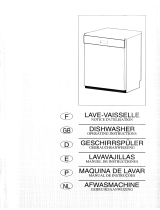
9
EN
2 / INSTALLING YOUR DISHWASHER
The appliance must be at a standstill when
connecting to the electricity supply circuit.
Before connecting your appliance, ensure
that:
- The mains voltage indicated on the manufac-
turer’s plate on your machine (230V) matches
the voltage supplied by your installation.
- Your meter and the fuses can support the
current. A 16A fuse is the minimum require-
ment.
If you must connect your appliance to a diffe-
rent voltage from that indicated on your
machine, connect an appropriate transformer.
NB :
Use the services of a qualified electri-
cian to make the modifications and ensure
that your electrical installation complies with
the regulations.
This appliance must necessarily be connec-
ted directly to an earthed plug and socket.
In all cases, it must be connected in accor-
dance with the prevailing regulations in the
country concerned and any additional regula-
tions from the local electricity utility.
Warning :
The plug and socket must be accessi-
ble even after your appliance has been ins-
talled. The appliance must not be connected
via an extension lead, a multiple socket or an
electric time delay programmer. (Fig. 13)
We cannot be held responsible in the event
of an accident or an incident caused by the
lack of or a defective earthing system.
Your dishwasher complies with European
Directives 73/23/EEC (Low Voltage Directive)
and 89/336/EEC (Electromagnetic Compatibility)
as modified by Directive 93/68/EEC.
•
Replacing the power cable
Danger :
For your safety’s sake, this operation
must only be performed by the manufactu-
rer’s After-Sales Department or by someone
with similar qualifications in order to avoid
any risks.
•
Appliances delivered without a plug
Danger :
The wires in your appliance’s power
cable are coloured as follows:
- Green & Yellow Earth
- Blue Neutral
- Brown Live
If the cable’s colours do not match your plug,
proceed as follows:
The wire coloured green and yellow must be
connected to the connector in your plug mar-
ked with the letter E, the symbol or colou-
red green and yellow.
The blue-coloured wire must be connected to
the connector marked with the letter N or
coloured black.
The brown-coloured wire must be connected
to the connector marked with the letter L or
coloured red.
Fig. 13
• ELECTRICAL CONNECTION









